Day: October 30, 2008
“Clearly, the sky is falling”
“The question now,” as N.Y. Times media columnist David Carr wrote today, “is how many people will be left to cover it.” Print people, he means. Yes, I too read this story online. I never read the print version of the Times, although, as I’ve said repeatedly over the last four or five years, I would be very saddened to live in a world in which you couldn’t buy the print edition. As I do six or seven times a year when I’m in a sentimental, old-fashioned mood.
Tracking
Clint Eastwood‘s Changeling, going wide this weekend, is running 74, 37 and 19 — very heavily skewed towards older women, at least $20 million. The Haunting of Molly Hartley is at 43, 28 and 5. Rock n Rolla, going wide ,also has a 34, 22 and 1…nothing. Kevin Smith‘s Zack and Miri Make a Porno is running at 66, 33 and 13. Younger males, of course. Looking to be one of the better Weinstein Co. openings in a long while.
Madagascar: Escape 2 Africa opens on 11.7, and is now at 90, 38 and 9. Over-25 women with kids. Pretty good business. Role Models is at 44, 35 and 5….decent. Soul Men is at 59, 32 and 3. Quantum of Solace (Sony, 11.14) is at 70, 53 and 15 — very strongly male, both older and younger.
DIsney’s Bolt, opening on 11.21, is at 58, 28 and 3. Twilight, sure to be a big hit with under-25 women, is running at 44, 39 and 8.
White, Black and Red
Apparently this is the final, decided-upon poster for Valkyrie (MGM/UA, 12.26) for the U.S. market. It’s a fairly riveting image — strong, exciting, tells you it’s a solid thriller — but let’s be frank and acknowledge that one reason it’s working is that it’s pushing familiar buttons. My first thought was “kinda Reservoir Dogs-y.” Then Ocean’s 11 came to mind. Not that there’s anything wrong or unwise about that. These are two very popular films.
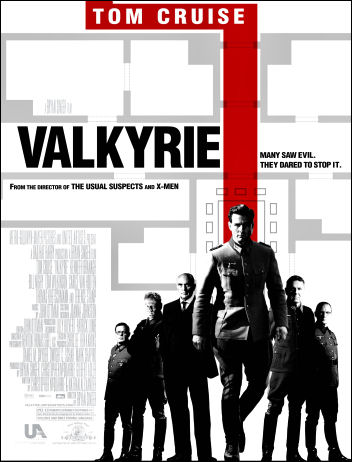
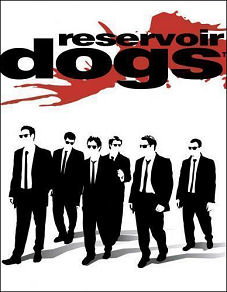
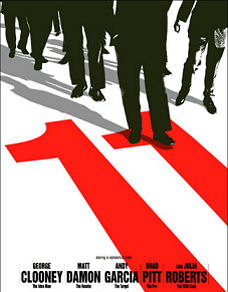
Best of the Best
As I understand it, David Fincher was asked by Empire to write down his favorite films of all time, and to do so without thinking about it too much — just scribble ’em down! So as an exercise, I grabbed a notebook and did the same thing. I wish I’d been a little more foreign, a little more ’90s indie, a little more ’30s, ’40s and ’50s…but this is what happened. Live with it. I could have written down another 150 without blinking. Here are the two lists:
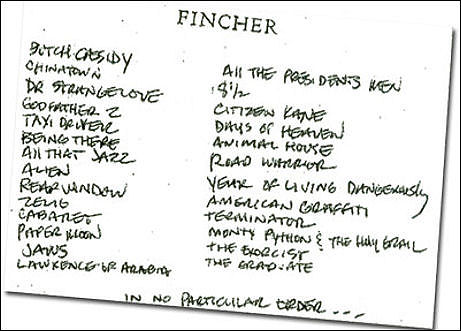
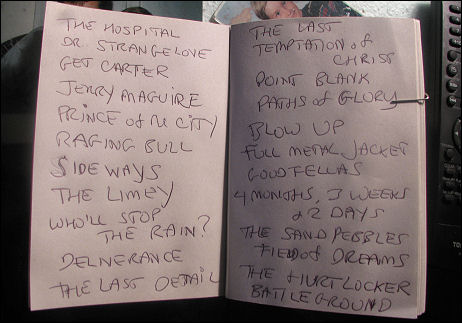
Tricks and Sadness
About a month ago Josiane Balasko‘s Cliente, about a 51 year-old businesswoman (Nathalie Baye) paying for the no-muss, no-fuss sexual services of a younger man, opened in France. This struck me right away as a good idea for an American remake. Especially with a classy, high-pedigree actress of a certain age — Kristin Scott Thomas or Meryl Streep, let’s say — in the lead role.
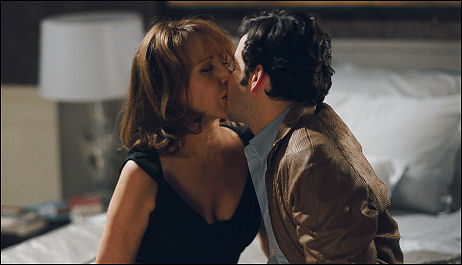
Over and over I’ve walked the aisles of Gelson’s and Ralph’s in the evening and seen women in business suits pushing their carts, alone and guarded and yet, you can tell, quietly hurting for something else besides this. Perhaps resigned to not having a relationship but not willing to turn themselves off to the extent that they have no life except work, sleep, girlfriends, exercise, pets, children and DVDs. If I were a producer I’d be looking into the remake rights as we speak.
Balasko, 58, has told N.Y. Times reporter Elaine Sciolino that her goals in making the film were twofold. One, “to shatter a long-held taboo in France” and two, “to send a positive message to middle-aged women who find themselves alone and wanting sexual fulfillment.”
Balasko says that “a lot of my friends are alone, lonely, divorced, and they can’t always reinvent themselves with another man and a new family So I decided to show a female client of a male escort. She’s not a victim but a woman who is in control of her life, her feelings, her sexual pleasure.”
Is someone going to tell me things are different for older single American women? That they don’t share the same situation, and don’t feel and want the same things? As long as they believe that satisfaction can be had with the proper safeguards and allowances for modesty?
Prostitution, says Balasko, “is the last sexual territory owned by men. [They] are in control of pleasure and have the right to buy it. Women do not.”
Bubba Nosferatu
No, not Elvis as a semi-vampire, which seems (am I wrong?) to be the idea in Don Coscarelli‘s forthcoming Bubba Nosferatu.
I’m sorry but my Space Elvis idea (i.e., a script I wrote ages ago) is better: Elvis was kidnapped by aliens in August 1977 just before he died, and flown back to the aliens’ home planet. He was restored, cleaned up, de-drugged, probed, kept in a large home (facsimile of Graceland) for 32 years, and then returned to earth in 2009 as the same 42 year-old he was before only much thinner and full of vim and vigor and ready to rock out. Except nobody believes he’s the real Elvis (naturally) so the only gig he can get is performing as an Elvis impersonator.
AICN’s Quint recently spoke about Bubba Nosferatu to Paul GIamatti, who will play Colonel Tom Parker to Ron Perlman‘s Elvis Presley. Ron Perlman? This isn’t going to work.
I saw Coscarelli’s Bubba Ho-Tep at Cinevegas three or four years ago, and it was immediately clear to me that Coscarelli is a great idea man but not much of a filmmaker. The movie was slow, not well shot, the absurdity of the plot overwhelmed the versimilitude, it had no story tension, it felt cheesy, etc.
Giamatti shared some of the details in the Quint interview. “I don’t want to give too much of it away! So yeah, I’ll be playing Col. Parker, who.. You know part of the great thing about this is not only are these wonderful genre movies, but he’s actually taking a weird, interesting take on the whole Elvis myth and kind of investigating the whole Elvis myth in a really interesting way, so it’s got a lot of stuff about Col. Parker being responsible for a lot of what happened to Elvis and kind of literally making him a vampire in some ways, you know? A kind of a blood sucker
“It plays on a lot of things, this movie, in a great way and it’s got Sitting Bull in it and there’s a peyote trip in it that is amazing and it’s just a big leap beyond the other movie. It’s ten times more insane and bizarre and it’s great and hilarious, too. It’s funnier than the other one is even. It still ends up being this great character study of this Elvis guy.”
Morris Does It Again
A day after speaking with Errol Morris about Standard Operating Procedure on or about 4.11.08, I wrote a piece titled “Morris Should Sell Obama.” The idea was to re-boot Morris’s brilliant spots for John Kerry in ’04, which focused on “real people” (mostly Republicans) who’d voted for Bush in 2000, but were going for Kerry that year.
I think they’re brilliant and very effective, despite what the usually perceptive Glenn Kenny had to say. I’m sorry but these spots really get me. In the heart, I mean. I actually got a little choked up.
Here are a series of individual spots by (a) Suzanne Lentz, (b) Bob Morgan, (c) David Hurwitt, (d) Bob Courtney, (e) Jennifer Pyrz, and (f) Brian O’Neill.
Here’s what Kenny said last April: “Jesus, Jeff. Errol Morris is the last goddamn thing Obama needs right now. Do you have no clue, even after all this time, about how the right-wing noise machine works? ‘Now we find the elitist Obama working with art-movie sweetheart Errol Morris, whose latest anti-American screed Standard Operating Procedure is hitting (hopefully not too many) theaters now…’ etcetera etcetera etcetera.
“Also, Morris’ spots didn’t do Kerry a goddamn bit of good.
“You can kick and scream and hold your breath until your face is blue about Gorilla America all you want, but Obama’s gonna need some of their votes if he’s gonna make it. And Morris ain’t gonna get them for him. This election is not going to work according to any of your noblest-case-scenario schemes.”
You were right about Obama needing Gorilla America, Glenn, but you were wrong about the Morris effect. There’s no way these new spots won’t persuade the nuclear physicists who are still sitting on the fence to pop for Obama. If they see them, obviously. If the spots get sent around and are linked to on the various sites. Four days to go.
The Idiots
Three days ago a funny New Yorker piece by David Sedaris about undecided voters appeared. “For as long as I can remember, just as we move into the final weeks of the Presidential campaign the focus shifts to the undecided voters,” it begins. “Who are they?” the news anchors ask. ‘And how might they determine the outcome of this election?’
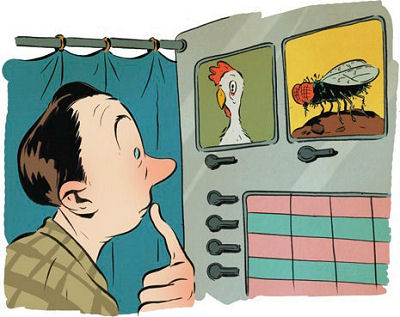
“Then you’ll see this man or woman — someone, I always think, who looks very happy to be on TV. ‘Well, Charlie,’ they say, ‘I’ve gone back and forth on the issues and whatnot, but I just can’t seem to make up my mind!’ Some insist that there’s very little difference between candidate A and candidate B. Others claim that they’re with A on defense and health care but are leaning toward B when it comes to the economy.
“I look at these people and can’t quite believe that they exist. Are they professional actors? I wonder. Or are they simply laymen who want a lot of attention?
“To put them in perspective, I think of being on an airplane. The flight attendant comes down the aisle with her food cart and, eventually, parks it beside my seat. ‘Can I interest you in the chicken?’ she asks. ‘Or would you prefer the platter of shit with bits of broken glass in it?”
“To be undecided in this election is to pause for a moment and then ask how the chicken is cooked.”
Show It Right
I’m attending the big Doubt screening at tonight’s AFI Fest kickoff, but because it’s being digitally projected I was asked — told — not to review it until I see it on a clean 35mm print in Manhattan sometime late next week. That’s the aesthetic exactitude of the film’s producer, Scott Rudin, talking.
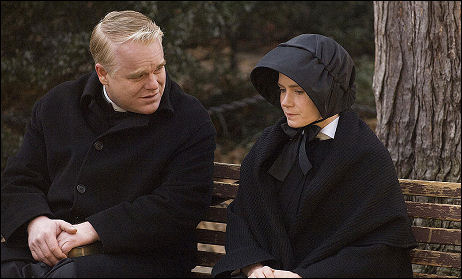
In line with this, Variety‘s Anne Thompson has reported that Rudin “was so appalled at the way the digital projection looked on the curved giant Cinerama Dome screen that he made sure the film will show on three flat screens at the Arclight.”
Correct again. That ultra-curved Cinerama screen is okay for watching revivals of How The West Was Won and It’s a Mad, Mad, Mad, Mad World, but terrible for almost anything else. Alan Parker, some may recall, was so appalled at Evita — shot in 2.35 widescreen — playing there in ’96 that he had a special flat screen installed.”
Doubt was shot in 1.85, and “gorgeously!,” I’m told. “Roger Deakins‘ work is stunning.”
“Modern Classic”
An “editor friend” recently sent Variety‘s Anne Thompson a note about from the first long-lead screening of Sam Mendes‘ Revolutionary Road: “The word from me is wow!….very powerful,” the guys starts off.
“[It’s a] two-hander for Leo and Kate, all grown up now as a married couple, unhappy but still in love. They go at it fiercely and you can sense the real-life bond that lets them really go for it, all defenses down.
“It’s powerful and also beautifully written and filmed. [American Beauty director] Sam Mendes doing suburban angst again, but this time in the 1950s. I daresay it may be a modern classic. The screenplay race this year is unusually light on adaptations, so this being an adaptation of the Richard Yates novel, I’d look for a nomination.”
